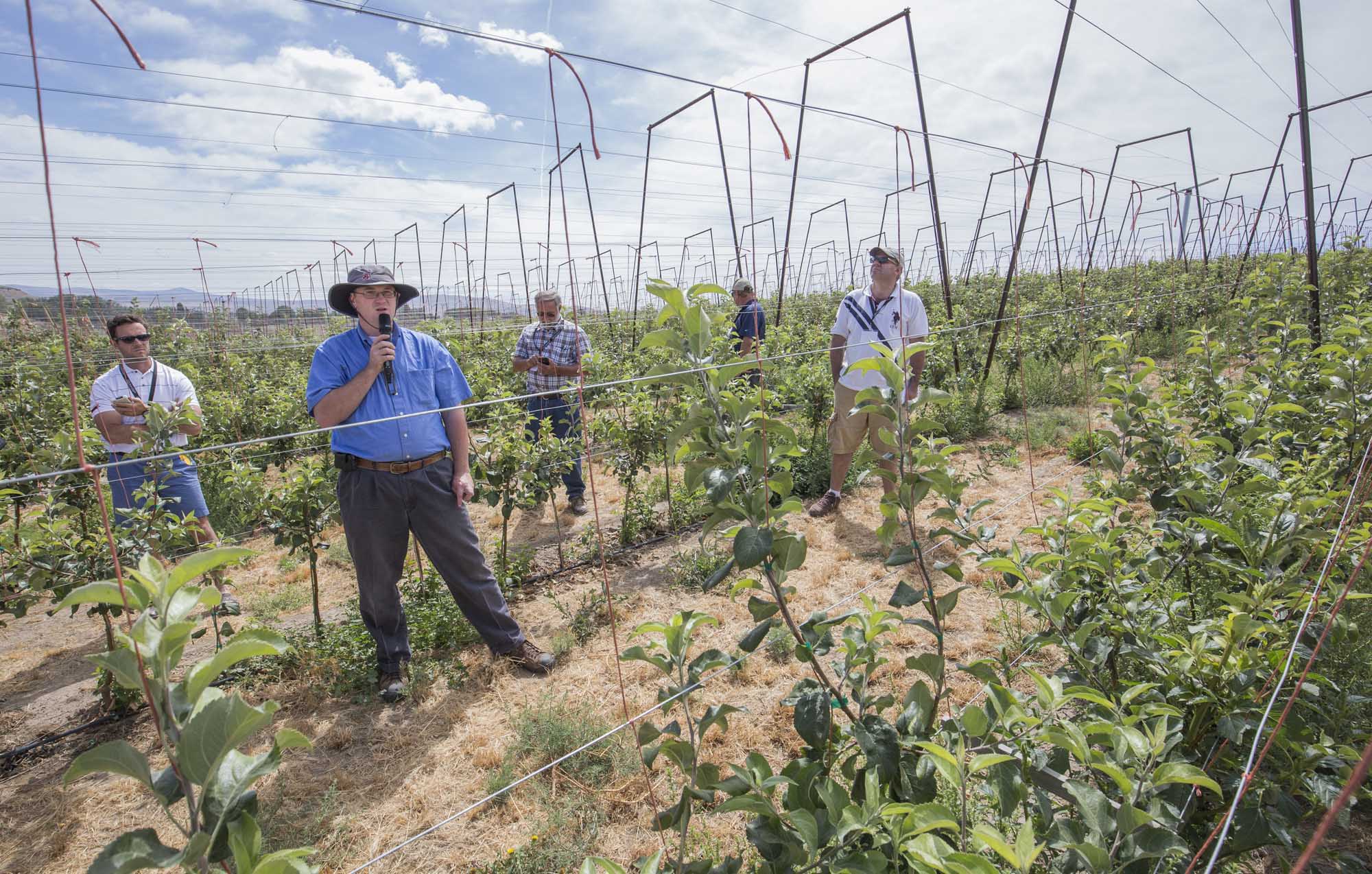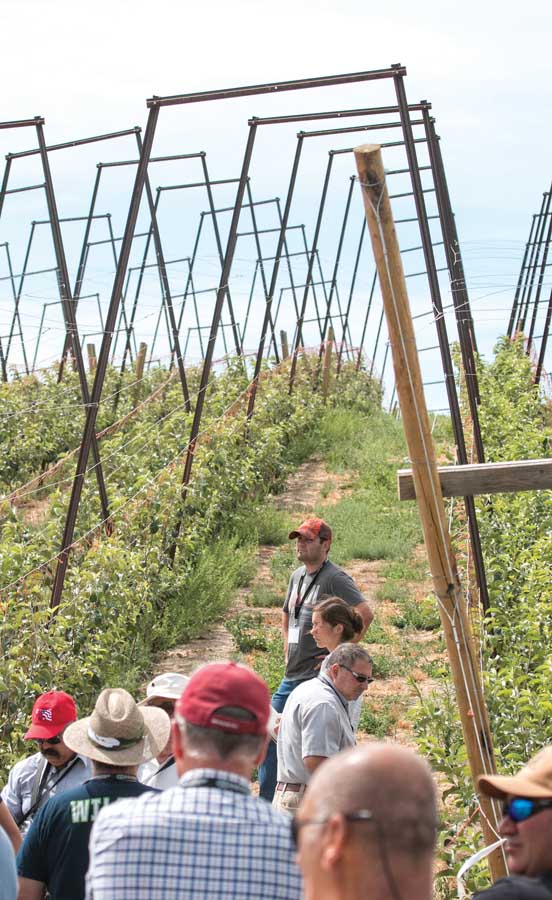
Jason Matson talks with IFTA tour members at one of his orchards in Selah, Washington on the second day of the tour on July 16, 2015. (TJ Mullinax/Good Fruit Grower)
Grafting over an existing orchard is a good way to establish a Honeycrisp orchard, Jason Matson believes, because it overcomes the typical problem of weak tree growth in the early years.
Honeycrisp trees are not very vigorous and tend to stop growing when they start to fruit.
“I’ve probably seen one block of Honeycrisp planted from trees that’s filled its space,” Matson told members of the International Fruit Tree Association, who visited his Selah, Washington orchard, during their summer tour this year. “I’m not aware of any others.”
Tom Auvil, research horticulturist with the Washington Tree Fruit Research Commission, argued that there have been a few Honeycrisp blocks that filled their space but agreed that many struggle.
Matson, who manages Matson Fruit Company’s orchards, grafted over a mature block of Jonagold on Malling 26 rootstock to Honeycrisp in 2010.
The trees are spaced 5 feet apart with 16 feet between rows. Each trunk had several grafts. The four most uniformly growing grafts on each tree were kept as leaders and trained to a V-trellis, with two leaders per side spaced about 2.5 feet apart down the row.
For the first few years, as the grafted leaders grew up, anything that wasn’t structure wood was cut off in an effort to remove flowering sites, and all blossoms were thinned off.
Matson fertilized the trees twice a week to encourage them to fill their space. Two years ago, when the canopy was almost fully developed and he wanted to begin cropping the trees, he applied only one shot of fertilizer in the winter. Last year, he applied none.
Last year, the block produced 82 bins per acre, but the fruit was not of the quality he would like because of the high vigor of the trees, and the cullage rate was high.
“We try to limit the number of fruit we have until we get 75 percent of the canopy filled,” Matson said. “Now we’re there, our problem is going to be how do you slam the brakes on these things and take them from vegetative and lousy fruit to reproductive with nice fruit.”
The block has a good yield potential, he pointed out. He estimated this year’s potential crop at 150 to 170 bins per acre. The blossoms were only lightly hand thinned in order to divert as much of the trees’ energy as possible into growing fruit rather than wood. He intended to thin the crop down to 100 to 110 bins per acre.
Matson also showed the IFTA tour group a block of Honeycrisp on M.9 Nic 29 rootstocks he had planted as trees in 2008 and trained as single leaders on a vertical trellis. The block had not been what he hoped it would be.
“The trees runted out too early,” he said. “We let them flower too early on, and just kept too much of the wrong kind of wood. The block grew really well for two years, and in the third year, it grew OK for a month and then it just stopped growing, despite all the fertilizer we put on it and fertilizer in subsequent years. We could never get it growing again.”
Karen Lewis, Washington State University extension specialist, said many Honeycrisp blocks planted in Washington in the 2008-2010 time frame look similar. Growers overcropped them at the expense of tree growth because they were anxious to get into production and have fruit to sell.
Matson said the majority of Honeycrisp blocks planted around 2008 might not even look that good. “That’s sort of a bad thing to say about some of my peers, but I’ve seen some blocks that looked horrible. I should probably feel good that it looks like it does, but it’s not good enough.”
Shorter trees

IFTA tour members at one of Jason Matson’s orchards on the second day of the tour on July 16, 2015. (TJ Mullinax/Good Fruit Grower)
Matson noticed that his Honeycrisp trees rarely grew up to the top wire of his trellises, at 12.5 to 13 feet. Borrowing ideas from growers Dan Plath and Travis Allan, he planted a block in 2012 with a shorter trellis. To make up for the theoretical loss in height of the canopy, he planted the rows closer together.
Trees are 18 inches apart with 10 feet between rows. Trees were trained as central leaders and branches were clipped off to reduce the number of fruiting sites and delay cropping. However, the branches that grew back were only about 8 inches long and weren’t filling the lateral space. Matson decided last winter to cut back the trees and regrow them with two leaders per tree so that the short shoots would fill the space perfectly.
In recent blocks, some trees were planted as finished trees and some as sleeping eyes. A sleeping eye is a dormant budded rootstock that is grown in the nursery for only one season compared with two seasons for a standard nursery tree.
Matson plants sleeping eyes as early in the season as practical, usually the end of March or early April, using grow tubes to create extra warmth to encourage them to grow. When the grow tubes are removed, the trees are supported by individual stakes until the trellis is installed.
He generally uses bamboo stakes but recently has been investing in steel stakes for situations where the trellis installation might be delayed. The metal stakes work well. Being more rigid, they can be inserted deeper in the ground.
Matson said he’s unlikely to plant any more Honeycrisp trees on M.9 Nic 29 and his most recent plantings have been on Geneva 890, which he hopes will generate a more vigorous tree.
There is no silver bullet for getting a Honeycrisp orchard to fill its space, he concluded. “It’s a lot of little things. If you get behind and try to play catch up—I don’t think you can do that.” •
– by Geraldine Warner






Leave A Comment